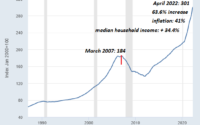The Dangers of a Declining China

China is on both the sending and receiving ends of global supply chains. Many of the finished goods it sends around the world come from assembling inputs that it imports from elsewhere. China’s significance in global commerce is due to its unique role as both the destination for natural resource inputs and the source of manufactured goods. China has earned its nickname: factory to the world.
The major recent development affecting global supply chains is the rise of Xi Jinping. After the chaos of Mao Zedong and the rejection of Maoism by Deng Xiaoping, China settled into a calm and orderly process of governance. The key was consensus. There would be a leader, but the leader would build consensus inside the Politburo, continue the economic growth started under Deng Xiaoping, and avoid high-profile blunders and confrontations.
Now, Xi Jinping has broken the mould. Through a series of Party Congresses and other forums, he has elevated himself to a place comparable to Mao Zedong in the pantheon of the Communist Party, enshrined the ‘Xi Jinping Thought on Socialism with Chinese Characteristics for a New Era’, and made it clear that he will remain in office beyond the customary expiration of his term in 2023. In effect, Xi is ‘president for life’ and the new Mao.
This change in leadership and governance has resulted in profound changes in policy. Xi actively attacks big tech and media firms inside China. He has pushed to de-list Chinese companies from Nasdaq and the NYSE and move those listings to the Stock Exchange of Hong Kong. He has crushed the last traces of democratic process and free speech in Hong Kong. And most dangerously, he has threatened to take Taiwan by force.
A dragon in the hen house
To put Chinese geoeconomic threats in perspective, it’s essential to gauge just how critical China is to global supply chains. The impact of China’s role goes far beyond the delivery and pricing of needed inputs and manufactured goods. China’s role as a supplier of commodities, components, and finished goods has strategic implications for the national security of its trading partners.
Strategic dependence varies by types of goods and the particular Chinese trading partner selected. Australia relies on China for 69% of its penicillin and almost 100% of its manganese, used in medicine and as a metallic alloy. New Zealand relies on China for 100% of its aspirin and 96% of its penicillin.
Canada imports 77% of its magnesium — used in specialised steel, electronics, and nanotechnology applications — from China. Canada also imports 71% of its shipping containers, 87% of its laptops, and 58% of its vitamin C from China. The US is no less dependent. Chinese exports account for 51% of lithium-ion batteries, 68% of certain rare-earth metals, 93% of laptops, and 52% of penicillin in the US.
These figures only scratch the surface of Chinese dominance of strategically important inputs to the global supply chain. China controls 39% of the global market for lithium-ion batteries, used in everything from smartphones to electric vehicles. China also accounts for 68% of global laptop exports and 62% of the global market of vitamin C, which has health benefits and is an ingredient in food preservation. Plus, China controls 80% of the global production of magnesium.
This litany of Chinese export dominance and the dependence of developed economies on key products seems to position China for the regional hegemony and global superpower status it seeks. Western analysts are counting down until Chinese GDP surpasses US GDP to make China the world’s largest economy. China already has the world’s largest population, the world’s second-largest economy, and the world’s fourth-largest nuclear arsenal.
Does the future belong to China?
Actually, no. China is moving quickly toward a world-historic economic and demographic collapse. And that is the single most important reason that global supply chains will collapse alongside it.
The reasons for China’s coming collapse are well known, if mostly ignored by the media. Of these, the most important reason is China’s looming demographic disaster.
China’s population is 1.4 billion people — about 17% of the world’s population. According to World Bank statistics, China’s birth rate is 1.7, well below a replacement rate of 2.1. But China’s situation is likely far worse than this high-level data suggests. There’s some evidence that China’s birth rate figures are overstated for political reasons, and the actual birth rate is close to 1.1 or lower. That will produce a shocking rate of population and economic decline.
On 17 January 2022, China announced that its birth rate in 2021 had declined for the fifth straight year. The New York Times reported:
‘China is facing a demographic crisis that is beyond the imagination of the Chinese authorities and the international community.’
A collapse of this magnitude would result in a crisis of political legitimacy and could presage the collapse of the Communist Party of China.
China is utterly dependent on the rest of the world for energy. China is the world’s largest producer of coal and generates about 58% of its electricity from burning coal. Despite China’s production, it still imports 300 million tonnes per year, mainly from Australia and Indonesia. China also imports more than 10 million barrels per day of oil, roughly equal to the total daily production of Saudi Arabia. China’s natural gas imports were more than 1.5 trillion cubic feet in 2020 and are rising at a rapid pace.
Other factors hindering Chinese growth and its ability to feed global supply chains are excessive debt, shadow banking, asset bubbles, real estate speculation, and overinvestment in non-productive infrastructure, including ghost cities and white elephant public facilities, such as train stations and airports. As much as 20% of China’s reported GDP growth in the past 15 years has been wasted on excessive construction that can never pay its way.
Analysts agree that Xi Jinping is now squashing the most innovative companies in China and promoting inefficient but malleable state-owned enterprises (SOEs). That approach will buy time, but it will kill growth and the innovation needed to support global supply chains.
The factory of the world is shutting down in stages.
Regards,
 |
Jim Rickards,
For The Daily Reckoning Australia Weekend
PS: This content was originally published by Jim Rickards’ Strategic Intelligence Australia, a financial advisory newsletter designed to help you protect your wealth and potentially profit from unseen world events. Learn more here.
[ad_2]
Source link


